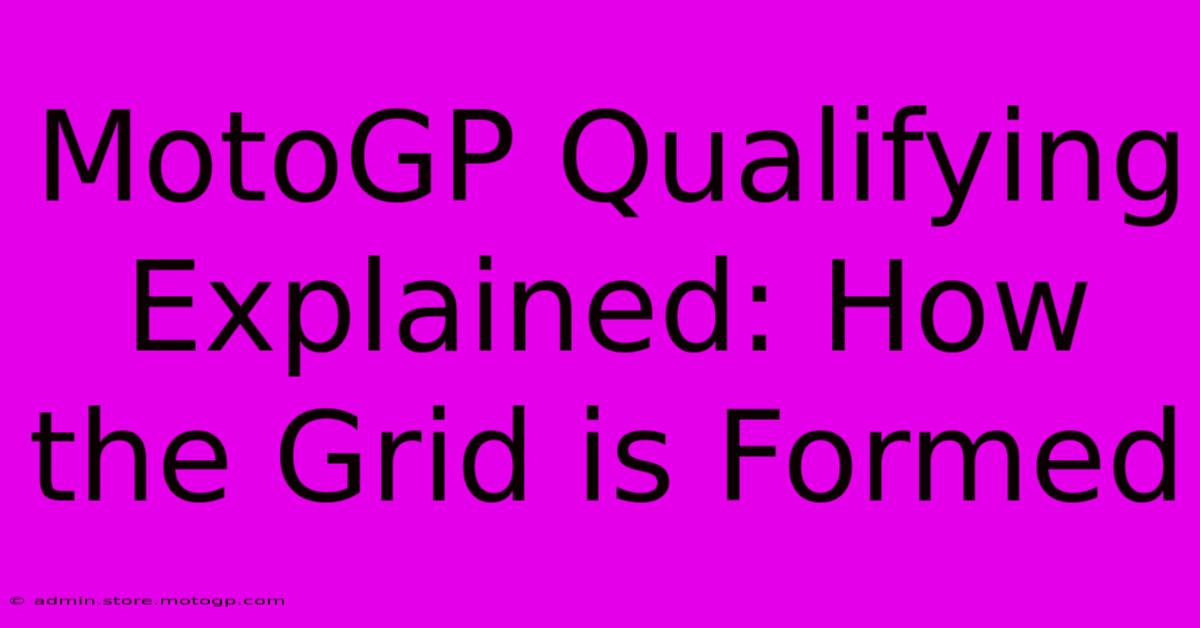MotoGP Qualifying Explained: How The Grid Is Formed

Table of Contents
MotoGP Qualifying Explained: How the Grid is Formed
MotoGP racing is a spectacle of speed, skill, and strategy. But before the lights go out and the bikes roar down the track, there's a crucial process that determines the starting positions: qualifying. Understanding how MotoGP qualifying works is key to appreciating the nuances of the race itself. This guide breaks down the entire process, explaining how the grid is formed for each Grand Prix.
The Qualifying Format: A Step-by-Step Guide
The current MotoGP qualifying format is designed to create excitement and showcase the riders' skills. It's a multi-stage process, culminating in the all-important Q2 shootout.
Q1 (Qualifying 1): The First Cut
- Who's involved? The ten slowest riders from the combined Free Practice 1 (FP1), FP2, and FP3 sessions find themselves battling it out in Q1.
- The Goal: The top two riders from Q1 automatically progress to Q2. The remaining eight riders start the race based on their finishing positions in Q1. This means that finishing even a fraction of a second ahead can make a significant difference.
- Time Limit: Riders are given a limited amount of time to set their fastest laps within this session. Track conditions, such as temperature and tire wear, can significantly affect performance.
- Strategy: Q1 is a high-stakes battle. Riders must balance pushing for a fast lap with managing tire wear to ensure they’re prepared for the race.
Q2 (Qualifying 2): The Showdown
- Who's involved? The top ten riders from the combined Free Practice sessions automatically qualify for Q2, joining the two fastest riders from Q1. This makes for a total of twelve riders competing for the coveted pole position.
- The Goal: The rider who sets the fastest lap in Q2 claims pole position – the most advantageous starting spot on the grid. Positions 2 through 12 are determined by lap times within this session.
- Pressure is On: Q2 is intense. The pressure is high to secure a good starting position, as it significantly impacts the race outcome. A slip-up in Q2 can mean a less-than-ideal grid slot for the race.
- Tire Selection: Choosing the right tires for this crucial session plays a vital role. The decision must balance speed and race durability.
The Importance of Qualifying
The starting grid isn't just about bragging rights; it's strategically crucial. A good starting position:
- Provides a Track Position Advantage: Starting at the front allows riders to control the race pace, particularly important on the first lap. Avoiding the chaos of the initial turns provides a significant advantage.
- Minimizes Risk: A front grid position reduces the likelihood of collisions and enables riders to avoid being trapped behind slower competitors.
- Influences Race Strategy: A better starting position allows riders to implement their race strategy more effectively, optimizing overtaking opportunities and managing tire degradation.
Factors Influencing Qualifying Performance
Several factors beyond rider skill determine qualifying performance:
- Bike Setup: The bike’s optimal setup is crucial for maximizing performance. This involves meticulous adjustments to suspension, aerodynamics, and engine mapping.
- Tire Choice: Selecting the right tires for the track conditions is paramount for achieving optimal grip and speed. This is a delicate balancing act between performance and durability.
- Track Conditions: Track temperature, humidity, and grip level significantly influence lap times. Adapting to changing conditions is a key skill for MotoGP riders.
- Slipstream: Drafting behind other riders, also known as slipstreaming, can provide a significant speed advantage, especially on long straights.
Conclusion: A Crucial Stage of the MotoGP Weekend
MotoGP qualifying is much more than a time trial; it's a strategic battle showcasing rider skill, team strategy, and the importance of precision. Understanding the process sheds light on the complexities and excitement of the sport. By understanding how the grid is formed, you can better appreciate the drama and implications unfolding on race day. The fight for pole position is a captivating spectacle in itself, laying the groundwork for the race ahead.

Thank you for visiting our website wich cover about MotoGP Qualifying Explained: How The Grid Is Formed. We hope the information provided has been useful to you. Feel free to contact us if you have any questions or need further assistance. See you next time and dont miss to bookmark.
Featured Posts
-
Yamaha Moto Gp The Global Reach Of Moto Gp
Feb 21, 2025
-
Moto 3 Bikes Transform Your Riding With Moto 3 Power
Feb 21, 2025
-
Moto Gp Images A Glimpse Behind The Scenes
Feb 21, 2025
-
Moto2 Bike Specs How To Optimize Your Bike For Performance
Feb 21, 2025
-
Sprint Race Results Unstoppable Force
Feb 21, 2025
